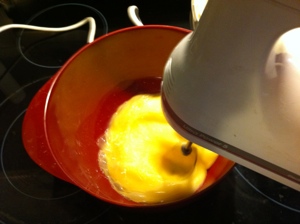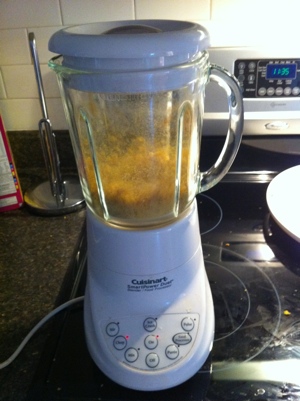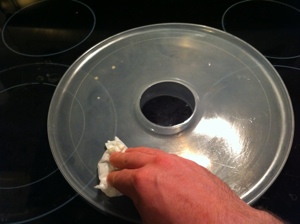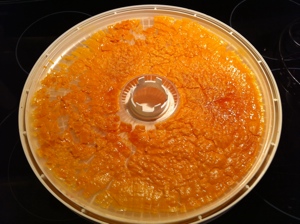The incredible edible powdered egg.
Here’s how you can do it at home:
What You’ll Need
- A food dehydrator –Any will do
- Eggs
- Something to store the powder in when complete
How to Make Powdered Eggs
The process for making powdered eggs is fairly simple. However there are two ways (one which creates a far superior product but more on that later), let me explain the process for both:(In these examples, I used a half-dozen eggs for the cook-dry method and another half-dozen eggs for the wet-dry method)
The Cook-Dry Method
 |
Step 1: Whip up a half-dozen eggs using a blender (for a more complete mixture). And then then in a non-stick frying pan, cook the egg solution like you would when making scrambled eggs.
|
 |
Step 2: Place cooked eggs onto a drying rack in your dehydrator and set the temperature to about 145 degrees Fahrenheit.
|
 |
Step 3: Let dry for around 4 hours until completely brittle throughout.
|
 |
Step 4: Chop dried chunks in a blender or food processor (or coffee grinder) until it has a fine powdery constancy. Bag it and store it away.
|
The Wet-Dry Method
 |
Step 1: Lightly grease a fruit roll sheet (it comes with the dehydrator) with a paper towel.
|
 |
Step 2: Whip up a half-dozen eggs using a blender (not necessary but it does make for a a more uniform mixture). Pour the egg slurry into the fruit-roll sheet and set the temperature to about 145 degrees Fahrenheit.
|
 |
Step 3: Let dry for around 16 hours until completely brittle throughout.
|
 |
Step 4: Place dried chunks in a blender or food processor (or coffee grinder) until it has a fine powdery constancy. Bag it and store it away.
|
Here’s a picture showing the final result of both the wet-dry and cooked-dry method of dehydrating. Each half-dozen eggs dehydrated produced almost exactly a half a cup of powder. You can also see how the wet dry method produces an orange powder (this color turns back to yellow when reconstituted and cooked).:

End Results
When comparing the two methods there is most definitely a clear winner — the wet dry method.---To preserve this add either salt or rosemary essential oil ( or sage-thyme-savoury-nutmeg-cinnamon) ( spray it on the mix prior to drying ) this will affect taste but it also affects benefit in amore effective way and protectthe lipids from breaking down and going rancid--If cooking the dehydrated egg (as you would with the original eggs) which will kill the salmonella.The only advantage I found with the cook-dry method is the quickness of the drying time (four hours compared to 16 with the wet-dry method). Beyond that, when reconstituting the cook-dried eggs and cooking them like scrambled eggs, they have a grainy texture, and they taste dry and stale. They also do not fluff up like normal eggs when cooked in a pan. I assume this lack of “rising” would not work to well in baked goods that require this “leavening” property.
The wet-dry method produces a much better product. Although the powder turns initially orange, when reconstituted and cooked like scrambled eggs, the orange turns to yellow and they taste, look, and feel just like non-dehydrated egss. They also maintain the “leavening” property and fluff up which is important for baking.
Here’s a picture of the two in powder form with their resultant reconstituted and cooked product:
No comments:
Post a Comment